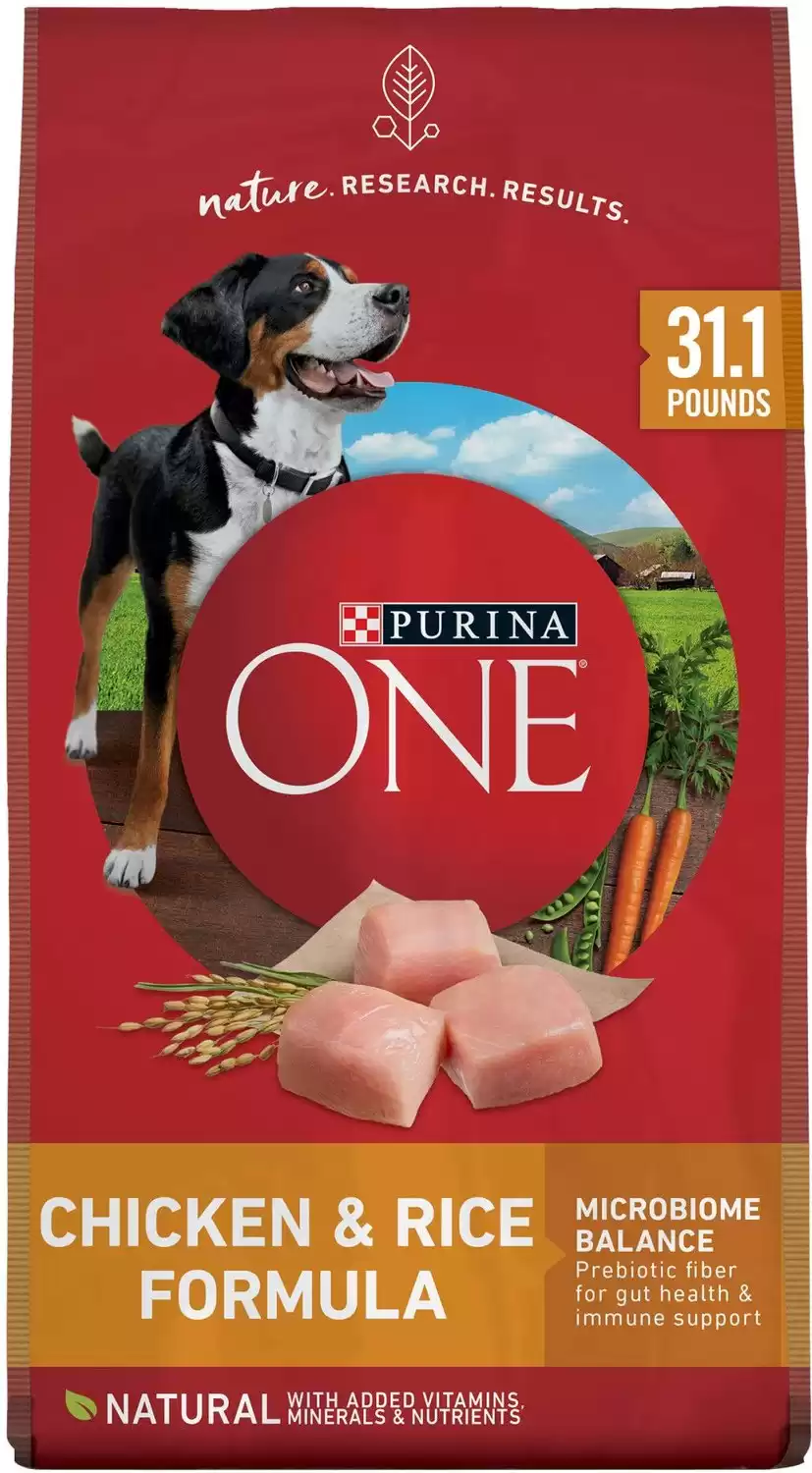Double Doodle
Canis lupus
Exact origin unknown.
Advertisement
Double Doodle as a Pet:
- General Health
- Energy Level
- Shedability
- Trainability
- Intelligence
- Tendency to Chew
- Size
- Family and kid friendliness
- Yappiness / Barking
- Low
- Hypoallergenic
- Yes
- Separation Anxiety
- Low
- Preferred Temperature
- Average climate
- Exercise Needs
- High
- Friendly With Other Dogs
- High
- Pure bred cost to own
- $800-1000
- Dog group
- Sporting
- Male weight
- 65-80 lbs
- Female weight
- 50-65 lbs
This post may contain affiliate links to our partners like Chewy, Amazon, and others. Purchasing through these helps us further the A-Z Animals mission to educate about the world's species.
View all of the Double Doodle images!
While it would seem that any breeder would be delighted to claim the honor of creating the Double Doodle, none ever have. Strange as it may seem, the breed may have been accidentally rather than scientifically called into existence.
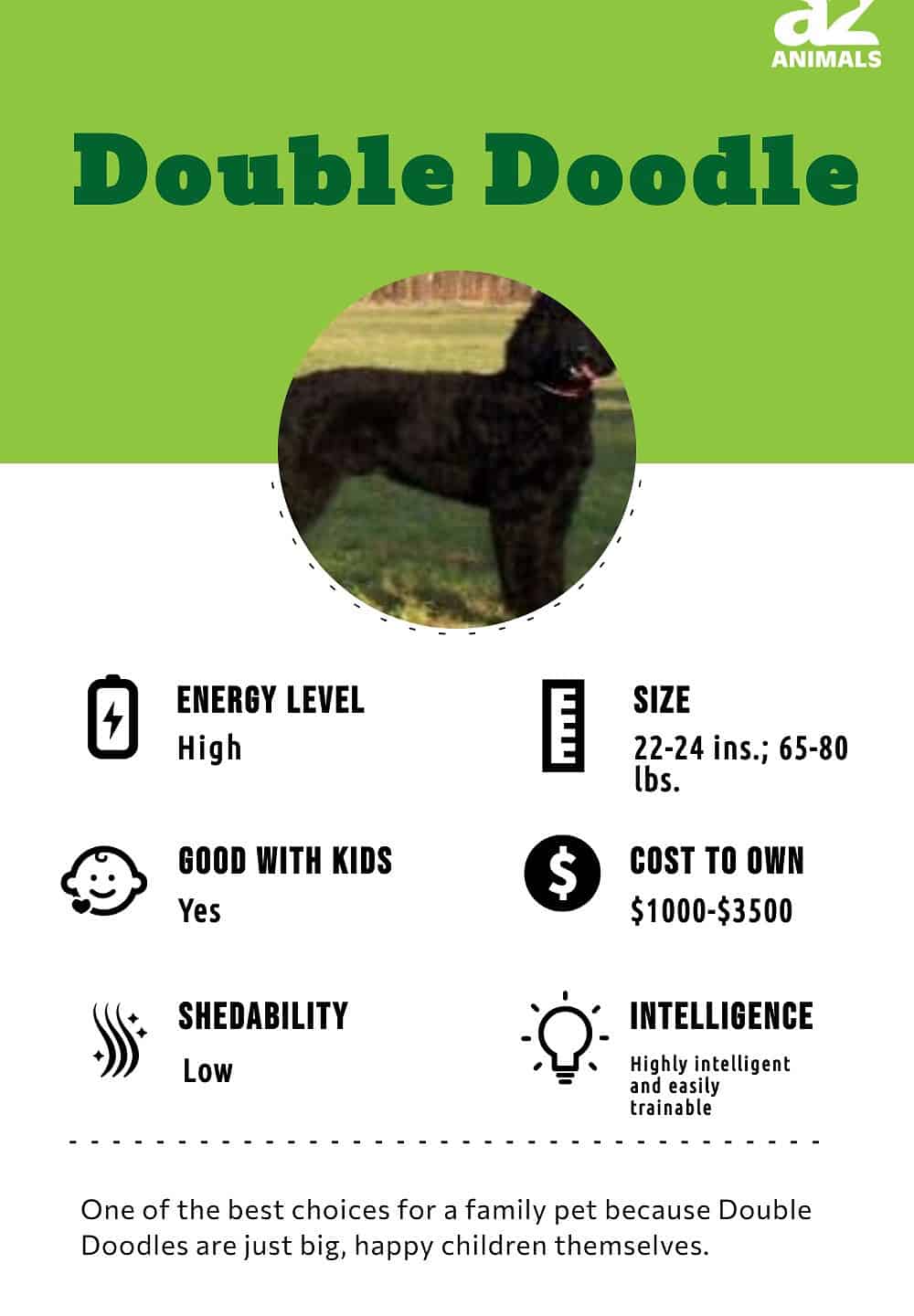
Curiously enough for a very modern breed of canine, the origins of the Double Doodle are uncertain. Regardless of how it came to be, the Double Doodle is an excellent example of dog genetics that match up several very popular and useful breeds to create an offshoot that seems to encompass virtually all of its parental virtues and very little of their drawbacks. A less common name for the breed is the North American Retriever.
See all of our expert product reviews.
So, what is a double doodle dog? The lineage of the dog revolves around a combination of Standard Poodle, Golden Retriever, and Labrador Retriever genetics. The Double Doodle name itself implies that it was originally a cross between two Poodle hybrids: the Golden Doodle, or Golden Retriever-Poodle, and the Labradoodle, or Labrador-Poodle.
This leads to several variants insofar as both appearance and genetics are concerned. As the offspring of two hybrids, it would have four parental genetic pools to draw from, two Poodle, one Labrador, and one Golden Retriever. Yet a Double Doodle can also come from one hybrid and a poodle, which leads to three parental groupings. This would be two Poodles and one of either the Labrador or Golden Retriever, depending on which variant is under discussion. In any event, all three scenarios are considered to be members of the Double Doodle family.
3 Pros and Cons of Ownership
| Pros! | Cons! |
| Intelligent and easy to train | Can be too friendly |
| Great family pet | Active dog that needs lots of exercise |
| Relatively easy care | Needs careful dietary planning |
Temperament
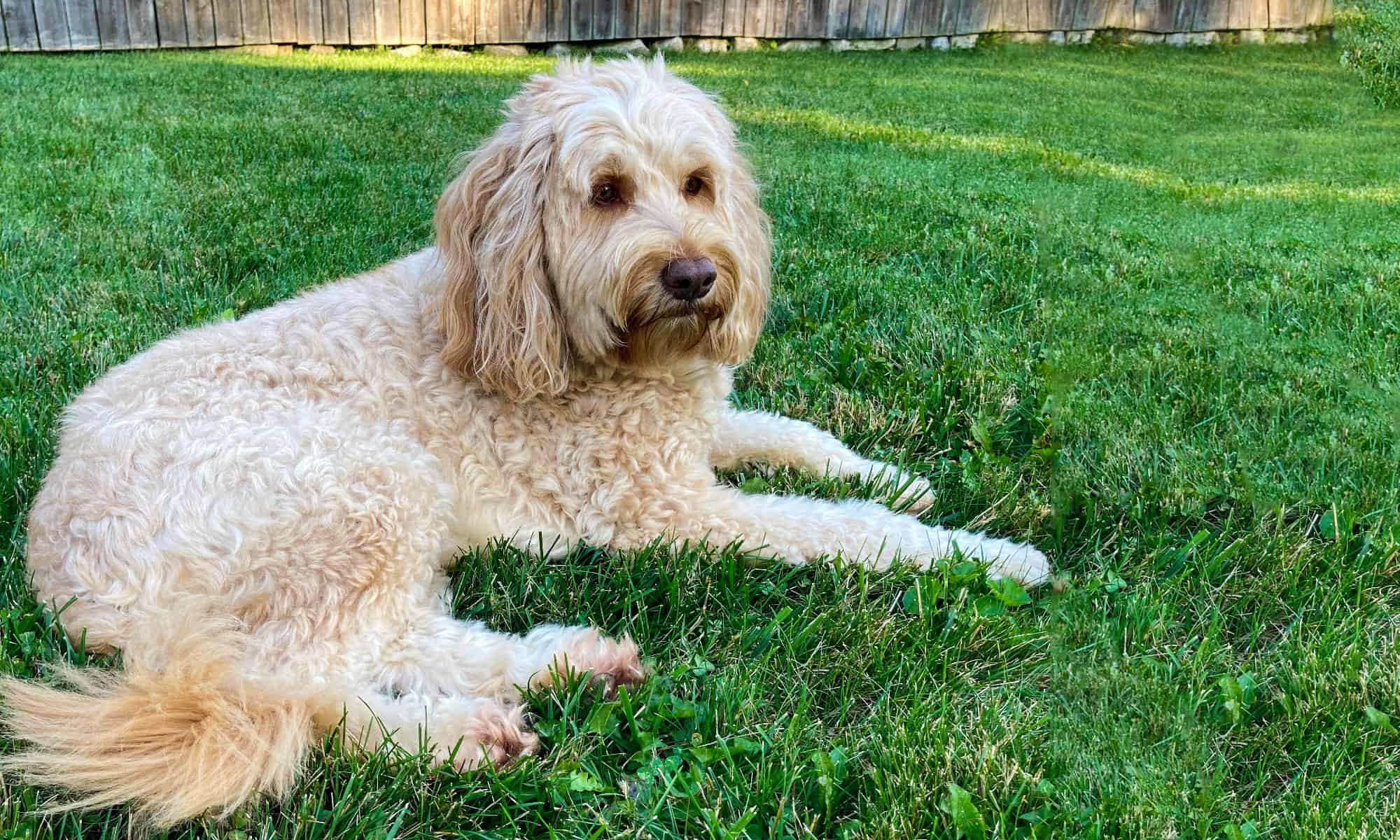
Double Doodles become trustworthy, valuable, and playful family pets, safe to be left around small children and other pets.
©Juli V/Shutterstock.com
Due to the different breeding methods, there are some variations in behavioral traits, but there is a definite range of likely temperaments that can be found among the entire group of Double Doodles. Overall, since all potential parental stocks are intelligent and friendly dogs, their offspring are also going to show similar baselines.
Health and Entertainment for your Double Doodle
- The Best Wet Food for Senior Dogs
- The Best Dog Food for Labrador Retrievers (Senior, Puppy, and Adult)
- These Are the Best Probiotics for Dogs (They Actually Work)
- Victor Senior Healthy Weight Dog Food Review: Recalls, Pros, Cons, and More
- The Best Dog Food for Small Dogs (Puppy, Adult, Senior): Ranked and Reviewed
See all of our expert product reviews.
One of the keys to getting the most out of the dog is to start it off properly. A firm, loving approach is essential to show it who is boss. With an appropriate place in the family hierarchy, Double Doodles become trustworthy, valuable, and playful contributors that are safe to be left around small children and even other pets such as the family cat. They are easy to train and mindful, although they also enjoy being playful and running around.
Size and Weight
The Double Doodle generally ranges in weight from about 50 to 80 lbs when fully grown. It is considered to be a large-sized dog but trending towards the smaller end of that large-sized spectrum. Specimens generally stand at about 24 inches or a little less when measured from ground to shoulder.
Smaller Double Doodles have been produced by including smaller Poodles rather than the large Standard Poodle which is the normal source of the Poodle part of their bloodline.
| Height (Male): | 24 inches |
| Height (Female): | 22 inches |
| Weight (Male): | up to 80 pounds |
| Weight (Female): | up to 65 pounds |
Common Health Issues
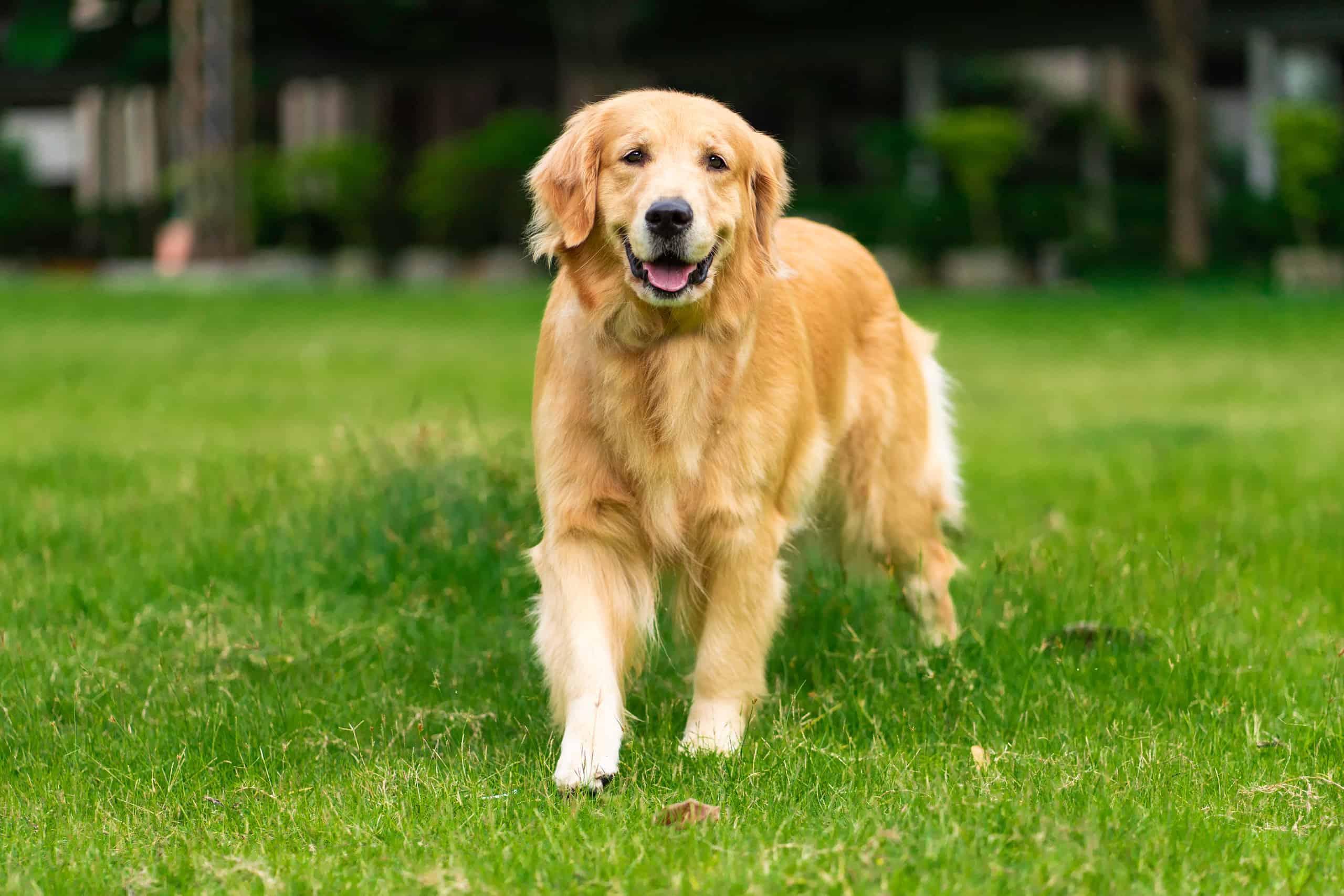
A Golden Retriever, like this one, might suffer from problems brought on by inbreeding that the Double Doodle would not have.
©Burin P/Shutterstock.com
One of the advantages of what is now called a hybrid is that genetic diversity is broader in comparison to one of today’s more tightly controlled classic breeds. Whereas Golden Retrievers, for example, have been inbred to the point where they often suffer from a litany of widespread breed-specific genetic problems, the Double Doodle has yet to suffer from inbreeding. The multiple ways to create a Double Doodle makes it less susceptible to the perils of inbreeding than almost any other hybrid dog.
Regardless, it still inherits problems common to its parental stock. Both Golden Retrievers and Standard Poodles have difficulties with their ears. While ear mites are not the result of genetics, they are more common in dogs with lots of hair in their ears, which can make them prone to ear infections.
Cataracts and hip problems are potential problems in the Double Doodle. Of course, these are diseases of age as much as ancestry, but older Double Doodles are more likely than the average canine to develop these issues.
Thanks to Poodle ancestry, they are prone to gaining weight without a balanced diet with minimal high fat additions like table scraps. This can worsen if the dog does not enjoy a regular regimen of vigorous exercise to help it burn off excess fat.
Care
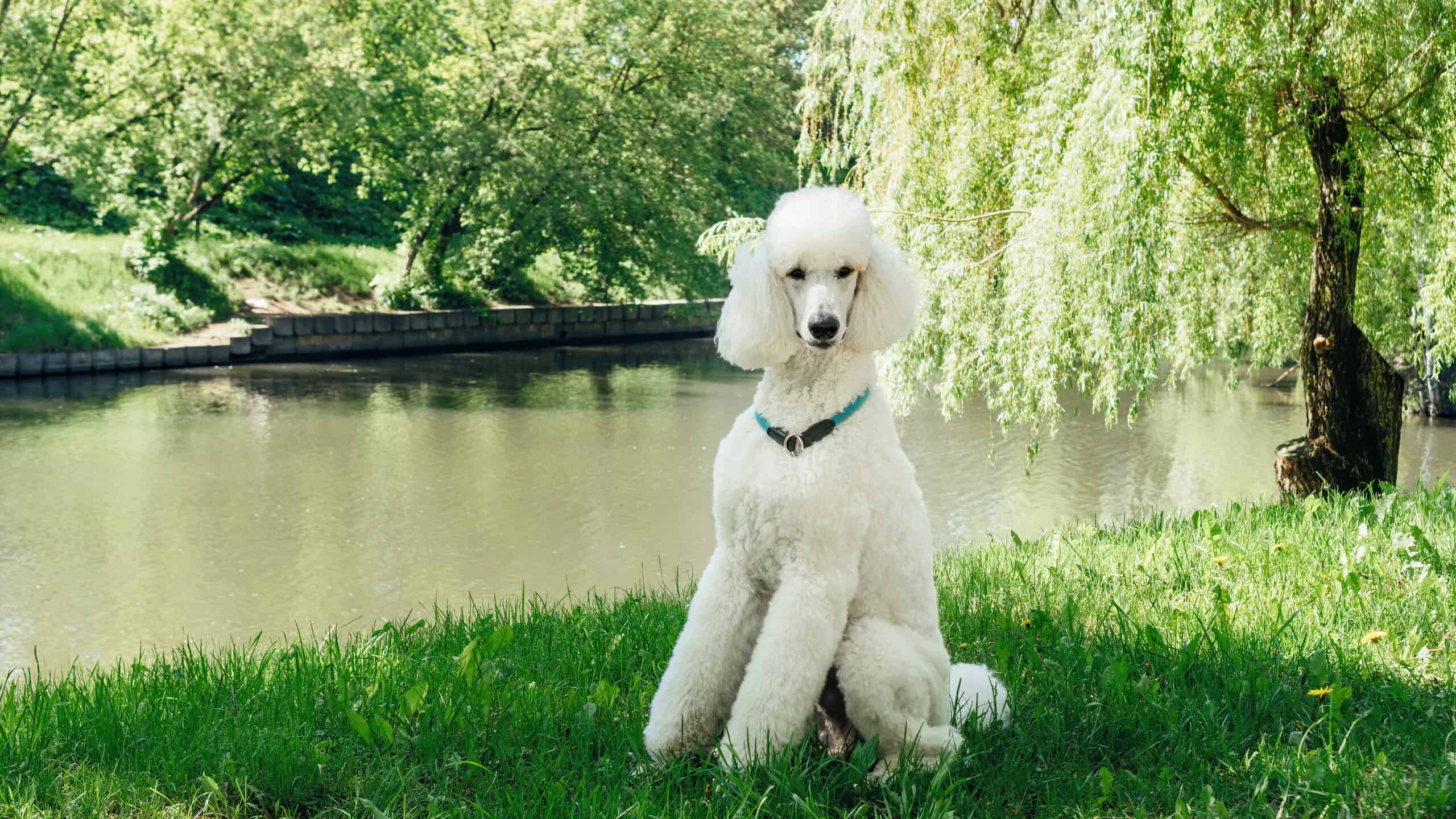
If a Double Doodle inherits a curly coat from its Poodle parent, it will need brushing and clipping for proper grooming.
©nieriss/Shutterstock.com
The major consideration when it comes to taking care of a Double Doodle depends on which side of the family is the dominant one. For those who have the curly Poodle coat, brushing and clipping will be in order. Those dogs that possess dominant Golden Retriever characteristics will require more brushing to keep the long silken coat from tangling and matting, yet there will be no need for Poodle-style trips to the dog groomers.
Since they come from hunting dogs (thus the alternate name of North American Retriever) Double Doodles need more exercise than some other less-active breeds. Long walks daily are very important to both the physical and mental well-being of these dogs.
Many active breeds can become bored and somewhat destructive if left in small spaces for lengthy periods. While Double Doodles can live in an apartment, they will need vigorous walking to compensate for their limited home horizons. Even a suburban pet will probably need more than just frisking around in the yard for the purposes of keeping healthy and fit.
Best Dog Food
As a result of their Poodle heritage, Double Doodles can develop gastrointestinal issues as they age if they are not kept to a fairly strict diet of proper dog food and no table scraps or treats. Nor should they eat just once daily since they are notorious scarfers who will rapidly eat every bit of what is put in front of them. Depending on their size, 2 to 2.5 cups of food per day for puppies and 2.5 to 3 per day for adults is generally sufficient for their dietary needs. This should be split into morning and evening meals.
A low-fat diet is essential. This should include glucosamine in order to guard against the hip problems that plague both Labrador and Golden Retrievers later in life.
For added health benefits to this relatively healthy breed, A-Z Animals thinks the best dog food for Double Doodles is Purina ONE SmartBlend Natural Adult Chicken & Rice Dry Dog Food.
The protein-rich ingredients are natural sources of glucosamine. A special antioxidant blend strengthens immune health so Double Doodles can shake off occasional ear infections.
Try out Purina ONE SmartBlend, available on Chewy or Amazon.
- Chicken and Rice formula semi-moist dry dog food
- Promotes healthy heart, joints, stomach, and coat
- High protein blend for strong muscles
Maintenance and Grooming
Double Doodles require a higher degree of daily and continuing maintenance due to their Golden Retriever and Poodle pedigree. They need regular brushing. This can be daily for the ones that inherit the Poodle coat and every other day for those with Golden Retriever traits.
For dogs with Poodle coats, regular trips to the groomer are in order. The good news, however, is that these Double Doodles are hypoallergenic and do not shed very much unlike their Retriever-dominant siblings.
Training
Double Doodles are well known for their ease of trainability so long as the process begins early. Once they have accepted a human as their pack leader, they are eager to learn and don’t easily forget what they have been taught previously.
Exercise
Benign neglect is not good for Double Doodles. Their owners need to commit to giving their pets regular exercise. The smaller the living space available to them, the longer and more frequent will be their need for walks and even runs. As water dogs, playing fetch is definitely a part of their repertoire but it is time and distance that counts even more than type of exercise.
Puppies
There are no significant differences between adults and puppies so far as special physical care is concerned. However, it is important to give a decent amount of individual attention to all puppies so that they will recognize and bond with their human companions.
Children
Since they have a large helping of the famously-friendly Golden Retriever in them, these dogs are just big happy children themselves. The breed is widely recognized as one of the best choices available for a family-friendly pet. That said, they are also highly intelligent and will not forget about mistreatment.
Similar Dogs

The Labrador Retrieve is one of the possible parents for a Double Doodle or a Labradoodle.
©Jagodka/Shutterstock.com
Naturally, there are some obvious similarities with their three parental lineages: the Golden Retriever, Labrador Retriever, and Standard Poodle. There is a much closer resemblance to their hybrid cousins, the Labradoodle and the Golden Doodle, for which they are often mistaken. In addition, the Standard Poodle can also appear very similar to the curly-hair portion of the Double Doodle breed.
• Standard Poodle: With their distinctive curly coats, the Poodle and part of the Double Doodle clan can easily be mistaken for one another. Both breeds are intelligent, playful, have similar colors, and share lineage as hunting dogs. The Poodle has some of the same gastrointestinal concerns but is less likely to have the cataract and hip degeneration issues found in a Double Doodle. Poodles are also much superior as watchdogs because of their increased proclivity to bark at strange persons and events.
• Labradoodle: Naturally enough, the hybrid Labradoodles have much in common with their near relation, the Double Doodle. Where they are different starts with caring for them. Many of the Double Doodles require a greater effort at brushing and grooming than the Labradoodle demands. The Labradoodle makes a better watchdog but also bonds more closely with humans. This can lead to more separation anxiety if left alone for long periods of time than is typically found with a Double Doodle. A Labradoodle is superior as a service or therapy dog and more at home on boats than a Double Doodle.
• Golden Doodle: The Golden Doodle has just enough differences from the Double Doodle to make it a very different choice for dog owners. Thanks to their longer breeding history, Golden Doodles are available in many more sizes. These range from very small, 15 lbs, to very large, 100 lbs. It is considered to be a little bit less intelligent and trainable than a Double Doodle. It is also believed to be even less useful as a guard dog than the Double Doodle. They are regarded as better pets for apartment dwellers and can be left alone a little more than a Double Doodle. They also eat less and have a slightly shorter lifespan than the Double Doodle.
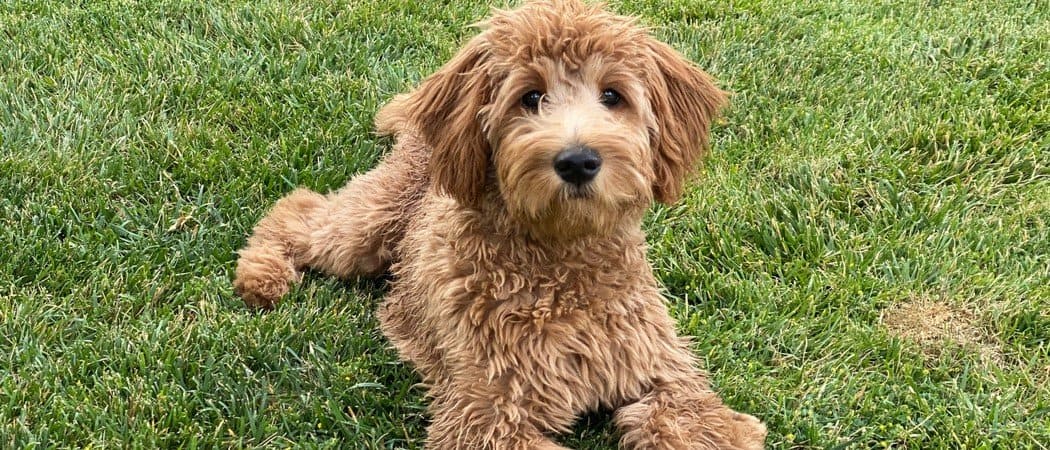
The Golden is a bit healthier, a little less alert, and more easygoing than the Double Doodle, but it is also more sensitive and less playful.
©cine-nomadic/Shutterstock.com
Double Doodle, or North American Retriever, versus Golden Doodle
Choosing either of these two popular breeds would be a good selection, but there are differences. The two types are very closely related and can often share many of the same colors, traits, and characteristics. Double Doodles come in more colors, which include black, brown, golden, white, tan, cream, and silver. The Golden Doodle can be found in black, gray, white, brown, red, and yellow.
The Golden is a bit healthier, a little less alert, more easygoing, and usually has larger litters of puppies. They are also a little more sensitive and a little less playful than a Double Doodle. The Double Doodle is smarter and more easily trained. The Double Doodle tends to have a more wiry coat than the Golden Doodle.
Popular Names for Double Doodles
- Sam
- Gizmo
- Jake
- Buddy
- Bella
- Dixie
- Millie
Double Doodle FAQs (Frequently Asked Questions)
What is a Double Doodle?
A Double Doodle is a multiple hybrid-hybrid mixed breed containing elements of Golden Retriever, Labrador, and Standard Poodle in their makeup.
Are Double Doodles hypoallergenic?
Yes and no. Poodle-dominant members of the family are hypoallergenic. Non-Poodle-dominants are not.
How big do Double Doodles get?
These are a medium-to-large dog that grows to about 80 lbs in weight and 24 inches in height.
How much do Double Doodles cost?
Well-bred puppies bring about $800-1000 to their breeders. The cost of keeping the dog is in line with other pets of their size.
Can Double Doodles be left alone?
Yes, but not forever. They like to play and socialize. If they are left alone for long periods, it is best to provide some extra attention upon returning to the home.
Is a Double Doodle good with kids?
Very much so.
How long do Double Doodles live?
12-15 years is considered to be the average lifespan of a Double Doodle.
Are there smaller, or mini, variants of Double Doodles?
Attempts have been made to produce a mini variant of the basic hybrid along the lines of a mini pinny but these efforts at breeding a smaller variant have not become widely available.
Would a rescue Double Doodle be a good choice?
These seldom show up in shelters due to their popularity, but a rescue Double Doodle would probably be a very safe choice in terms of temperament. This can sometimes be a hidden drawback for rescue pets.
What colors do Double Doodles come in?
Double doodles can be black, brown, golden, tan, white, cream, or silver in color.
Thank you for reading! Have some feedback for us? Contact the AZ Animals editorial team.
Sources
- dogbreedslist.info, Available here: https://www.dogbreedslist.info/all-dog-breeds/Double-Doodle.html
- petguide.com, Available here: https://www.petguide.com/breeds/dog/double-doodle/
- dog-learn.com, Available here: https://www.dog-learn.com/dog-breeds/double-doodle/#breed-maintenance
- dogell.com, Available here: https://dogell.com/en/compare-dog-breeds/double-doodle-vs-labradoodle-vs-goldendoodle





